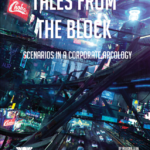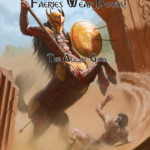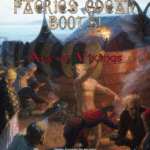Introducing the Three Pillars of Science Fiction
If you spend enough time reading any genre then you start to notice certain similarities that keep on cropping up. Sometimes these are deliberate and sometimes they’re accidental, and I’m convinced that half the time authors don’t even notice that they’re doing it.
Everything is inspired, at least in part, by something else. In fantasy, for example, it’s easy to see the lingering aftershocks of J. R. R. Tolkien’s Lord of the Rings. Even when a story doesn’t seem to have much in common with Tolkien’s epic, it can often be seen as a reaction to and a response to Tolkien’s trilogy.
This happens in all genres, and it’s generally not a problem unless they accidentally slip into cliché. In fact, fitting into these tropes can help writers to add some structure to their work while simultaneously making it more likely that readers will see something that they recognise and ultimately get drawn into the story.
As with most things in literature, there are no hard and fast rules, but there are general rules of thumb that make it easier for us to talk about complex subjects. And when it comes to science fiction, there are three main pillars that you’ll want to be aware of. Here’s what you need to know.
The Three Pillars of Science Fiction
1. Hard Science Fiction
Hard science fiction is interesting because it’s one of those genres where you know it when you see it. Still, there are certain commonalities to hard science fiction that we can look out for. In particular, there’s almost always a more serious and scholarly approach to the science itself, with authors going out of their way to ensure that all of the science is accurate, up-to-date and consistent with the latest theories.
It’s been argued that both hard sci-fi and its opposite, soft sci-fi, are really approximations for the purposes of classification, and it’s true that it’s more of a sliding scale than a binary thing. It’s often difficult to differentiate between the two, which means that it can become a source of debate as people argue the pros and cons for classifying any given piece under any given genre.
One way to look at hard sci fi is to examine the relationship that science has with the story. Most hard science fiction stories are rigorous in their approach to the theory and application of science, and they also often deal with the moral and ethical questions that can arise as the speed of scientific development continues to hasten.
It can also lead to interesting problems, such as when our scientific understanding develops and we discover that a plot point that was previously viable is no longer in line with current scientific thinking. Some fans of the genre even make it their mission to hunt out and spot inaccuracies, and that’s actually good for the rest of us because it helps to make sure that authors are kept on their toes.
Some of the most well-known hard science fiction works include:
- 2001: A Space Odyssey by Arthur C. Clarke
- Brave New World by Aldous Huxley
- Contact by Carl Sagan
- Jurassic Park by Michael Crichton
- Ringworld by Larry Niven
- The Gods Themselves by Isaac Asimov (or basically any Isaac Asimov novel)
- The Three-Body Problem by Cixin Liu
- Twenty Thousand Leagues Under the Sea by Jules Verne
2. Space Opera
Space opera is a specific type of science fiction that tends to be epic in scale and which typically includes a heavy focus on politics and warfare. Basically, it’s Game of Thrones but in space. It takes its name from the idea that it’s the science fictional equivalent of a traditional soap opera, with plenty of moments of tension and high drama.
Another commonality between space opera stories is that they often contain elements of classic adventure tales, to the point at which the two can often be confused. More specifically, they also often borrow from soap operas and even old school horse operas (a term for generic westerns) and use similar storylines, simply porting the action into space.
Interestingly, space operas were once considered essentially defunct, especially after their heyday towards the start of the 21st century. There were claims that space operas had come and gone, but then Star Wars came along and inspired a boom of space operas in television, film and literature that ultimately led to its reestablishment as a legitimate genre.
David G. Hartwell and Kathryn Cramer, two well-known editors of science fiction anthologies, have given their own definition of what makes a space opera that gets to the heart of the point more than any other definition I’ve seen: “Colourful, dramatic, large-scale science fiction adventure, competently and sometimes beautifully written, usually focussed on a sympathetic, heroic central character and plot action, and usually set in the relatively distant future, and in space or on other worlds, characteristically optimistic in tone. It often deals with war, piracy, military virtues and very large-scale action, large stakes.”
Some of the most well-known space operas include:
- Dune by Frank Herbert
- The Star Wars movies
- The Lensman series by E. E. Smith
- Starship Troopers by Robert A. Heinlein
- The Flash Gordon series
- The Fifth Element (movie)
3. Cyberpunk Noir
Cyberpunk is a little bit like a science fictional version of steampunk, which itself tends to take place in Victorian settings. Cyberpunk is like looking at what would happen if those steampunk Victorian societies continued to develop into the future. Movies and novels in the cyberpunk genre often show the effects that technology often has on society, and they also often have elements of societal unrest and breakdown.
Cyberpunk novels also often tap into and reflect subcultures, such as reflecting the punk movement. It was popularised during the middle of the 20th century, with key figures including William Gibson and Philip K. Dick. A whole heap of Dick’s novels and novellas were turned into movies, and many of the movies have done more to solidify cyberpunk in our culture than the books could ever have accomplished, perhaps most notably in the case of Blade Runner.
Cyberpunk is different to the other genres on this list because it typically works best when the stories take place in the near future, as opposed to in the far future as is more commonplace for space operas and other more epic forms of science fiction.
We should also mention the noir part, as that’s important. This comes from film noir, a subgenre of film that tends to focus on cynicism, sexuality, drug use and other darker sides of human nature. Many of the original film noir movies were shot in black and white and they typically had crime plots at the heart of them. Cyberpunk noir takes these noir elements but then gives them a technological spin.
Some of the most well-known examples of cyberpunk include:
- Judge Dredd
- Neuromancer by William Gibson
- The Matrix movies
- Altered Carbon
Conclusion
For me, one of the most interesting things about these pillars of sci-fi is that they can be remixed together. Indeed it’s perfectly possible to bring all three of them together, although that won’t necessarily guarantee that it’s going to be a good read. For example, the optimism of a space opera doesn’t tend to work well alongside the cynicism of cyberpunk noir.
Still, there are countless examples out there of exciting new stories that are using elements from two or more of the pillars, and all of that crossover means that it’s an exciting time to be a science fiction reader – or even a writer.
Of course, you should take what we’ve talked about today with a pinch of salt because there are really no hard and fast walls when it comes to creativity. You don’t have to use one of the pillars to create a well-received sci-fi novel, but it’s also true when they say that you need to know the rules before you can break them.
Still, now that you know about these three pillars, I’m betting that you’ll start to see them everywhere, whether you’re actively looking for them or not. They can also be useful when categorising new sci-fi releases and if you’re a writer yourself, because they can give you a feel for what people are looking for and even just provide a little inspiration.
Now I want to hear from you. Be sure to let me know about some of your favourite sci-fi works in the comments so that I can check them out, and you can also go ahead and let me know which of the three pillars they fit under. I look forward to keeping the discussion going!













